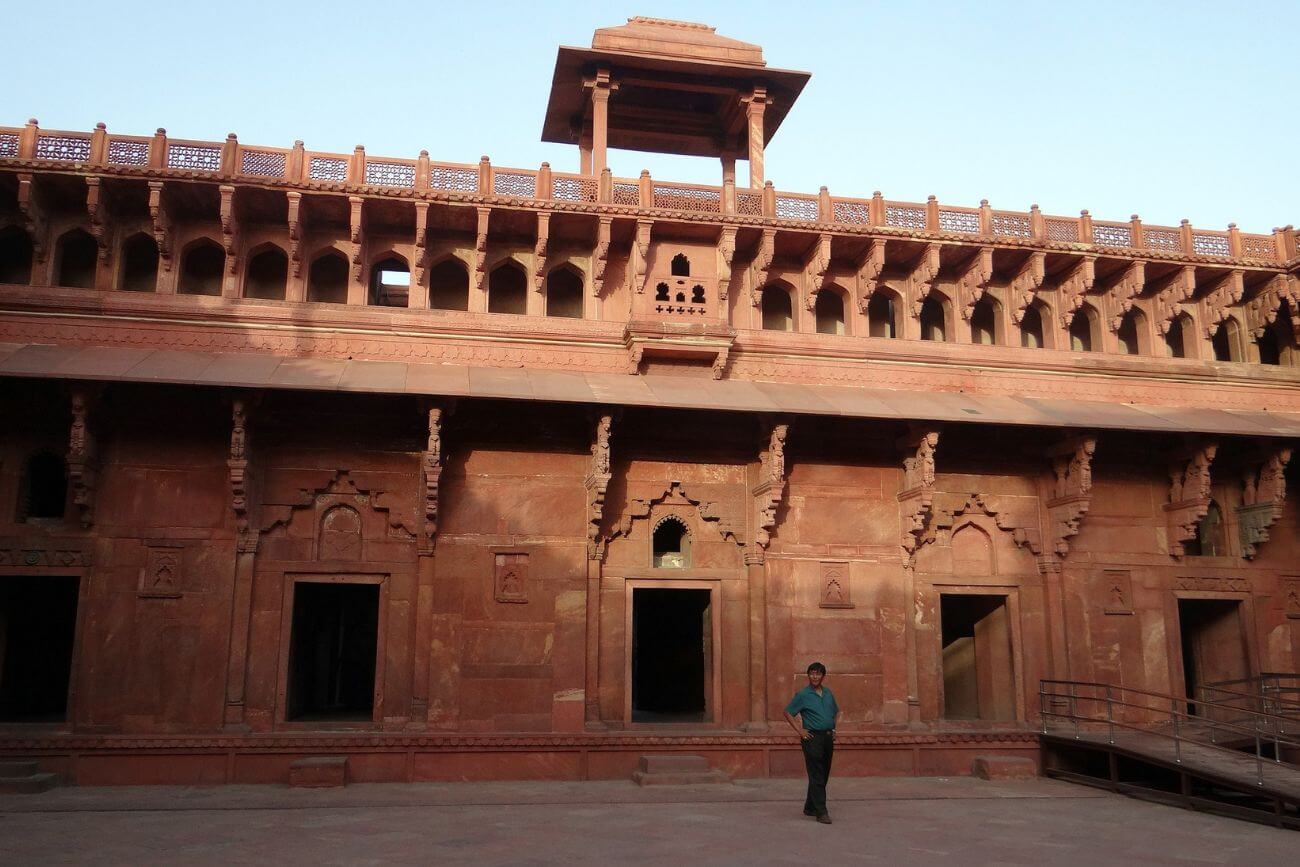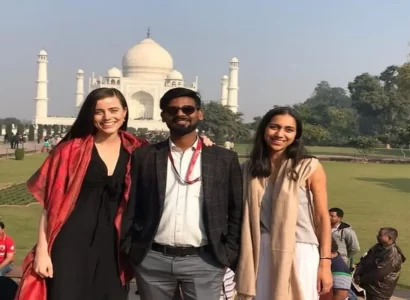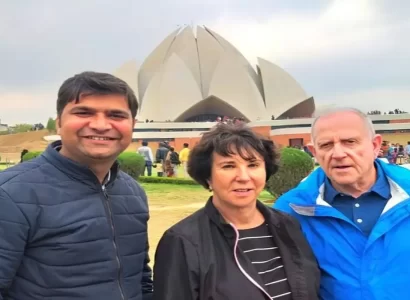Agra Fort is one of the UNESCO World Heritage sites in Agra. Located 2.5 km away from the Taj Mahal this fort has its own identity, beauty and history. In this article, we are going to take you down a trail exploring the nuances of the Agra Fort!!
HISTORY: SURPASSING ENDLESS NUMBER OF CONQUESTS
Agra Fort was constructed in 1573 during the reign of Akbar, one of the greatest Mughal Emperors. The fort required over 4,000 laborers and eight years of hard work to finish. Knowing the importance of its position, Akbar erected the fort to serve as the Mughals’ principal palace. Until 1638, the fort served as the primary palace of the Mughal emperors.
The fort is home to many magnificent structures, including the Jahangir Mahal, Khas Mahal, Diwan-i-Khass, Diwan-i-Am, Machchhi Bhawan, and Moti Masjid. The Mughal capital was shifted from Agra to Delhi in 1638, forcing the Agra Fort to lose its prominence as the chief seat of the Mughal emperors. The fort is divided by its sister monument, the beautiful Taj Mahal by just 2.5 km. And therefore visiting the two together is a great idea.
It all started in 1526, with the first battle of Panipat between Babur and Ibrahim Lodi of the Lodi dynasty. When Babur vanquished Ibrahim Lodi, he made the fort and castle of Ibrahim Lodi his permanent residence. He then altered the fort by constructing a massive step well (baoli) inside. The fort quickly became an important Mughal landmark.
In fact, the crowning of Babur’s successor, Humayun, took place at the fort in 1530. Soon after, emperors from other dynasties began to eye the fort, and efforts to conquer it began. Sher Shah Suri of the Sur Empire made war against Humayun and defeated him at Bilgram in 1540.
Sher Shah Suri acquired ownership of the Fort and redefined it as per his own architectural taste. The Fort remained in the hands of the Sur dynasty for 15 years i.e. till 1555, then it was recaptured by Humayun, only to fall in the hands of Hemu Vikramaditya, who then came to Akbar who rebuilt it with red sandstone.
During Shah Jahan’s reign, the fort was significantly altered and took on its current form. Shah Jahan demolished parts of the fort’s structures and rebuilt them in his own architectural style. The Maratha Empire seized the fort in the early 17th century. Various Maratha emperors and their adversaries, including a slew of Mughal monarchs, owned the fort during this time period. The Marathas were humiliated by Ahmad Shah Durrani, the founder of the Durrani Empire, in 1761. The Durrani dynasty’s rulers lived in the fort until 1785. Under the reign of Mahadji Shinde, the Marathas reclaimed the fort in 1785. The Marathas were then defeated by the Britishers in the Second Anglo-Maratha War, and since then the whites enjoyed the comfort of the Fort, till it was handed over to the government of India in the year 1947.
LAYOUT
When viewed from above, the fort has a semi-circular shape. The fort’s base is located on the bank of the Yamuna River. The Agra Fort is surrounded by a magnificent red sandstone wall with twin battlements. This wall has a perimeter of roughly 2 kilometres and is broken up by beautiful bends and tall bastions. The fort’s walls rise seventy feet above the ground. The fort is over 2.5 kilometres long. It has four entrances (one on each side). The Delhi and Lahore gates are the most visible of the four gates. Later, the Lahore Gate was called Amar Singh Gate. Akbar used the Delhi gate as his main entry, and it also acted as a deterrent to intruders. The gates are designed in such a strong manner that invaders found it immensely difficult to enter even with war elephants.
ARCHITECTURE
The entire design of the Agra Fort has undergone various changes ever since its inception. Initially, it was designed out of red sandstone, especially from Rajasthan. However since Shah Jahan was fond of white marble, he redesigned various structures within the Fort with white marble. Shah Jahan was made to spend his final days in the Musamman Burj of the Agra fort, which was built by him. The Musamman Burj is located on the left of the Khaas Mahal. It is a beautiful octagonal tower with an open pavilion. It is said that Shah Jahan used to view the Taj Mahal from this very place. Britishers further destroyed various edifices present in the fort citing political reasons. But the ones which managed to live through history are a clear reflection of architectural complexity, designing plurality and contextual multiplicity. Structures such as the Amar Singh Gate or the former Lahore Gate, Delhi Gate and Bengali Mahal are representative of Indo-Islamic or Akbari architecture. This architectural marvel is also full of legends one of which suggests that the royal rooms in the Fort were made hollow and filled with water from the river to keep them cool even during the summers of Agra.
Jahangir’s Hauz – Jahangir constructed this massive tank. Initially, the tank was used for bathing. It is presently incorporated into Akbar’s Bengali Mahal.
STRUCTURES WITHIN AGRA FORT
- Shahjahani Mahal – The Shahjahani Mahal was most likely one of Emperor Shah Jahan’s first attempts to convert a red sandstone castle into a white marble palace.
- Babur’s Baoli (step well) – Babur constructed a stone step well to meet the water needs of the ancient fort of Agra. This was most likely one of the fort’s first renovations.
- Nagina Masjid – Shah Jahan erected the Nagina Masjid, a mosque. The mosque was constructed entirely of white marble and was intended to be a private place of worship.
- Shah Jahan constructed the Diwan-I-Am (Hall of Public Audience). Interestingly, the hall was originally constructed of red sandstone but was later shell-plastered to give it the appearance of white marble.
- Ghaznin Gate – The Ghaznin Gate actually belongs to the tomb of Mahmud of Ghazni, one of the Ghaznavid Empire’s kings. The British moved the gate into the fort for political reasons.
- Bengali Mahal – This palace was constructed by Akbar and then modified by Shah Jahan. One intriguing characteristic of this castle is that it is claimed to include subterranean buildings concealed beneath the palace.
- Akbar Mahal – Akbar breathed his last here. The ruins of the
- A completely red sandstone structure remains to date.
Agra Fort is one of the most famous tourist destinations in Agra, Unlike the Taj Mahal it offers a rich history full of conquests, victories, valour, subordination and freedom. Having lived through ages of dynastic rule from across the length and breadth of India as well as the invaders from across the world, finally falling into the hands of the colonizers. Agra Fort has stories, myths and legends to narrate that have left indelible imprints on the sands of time.







